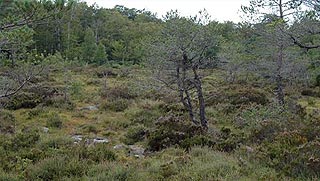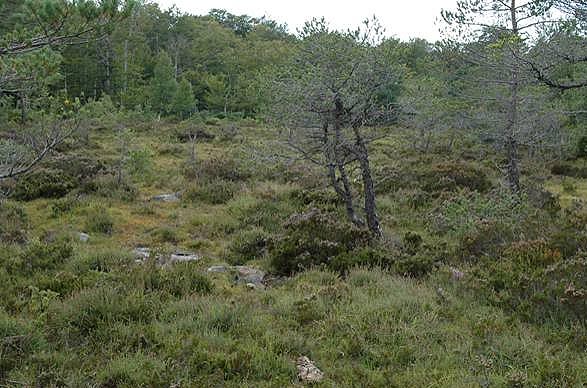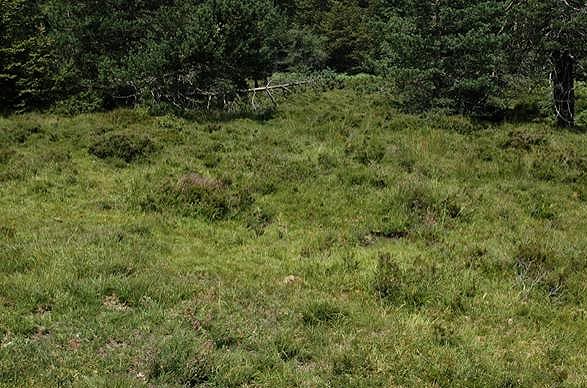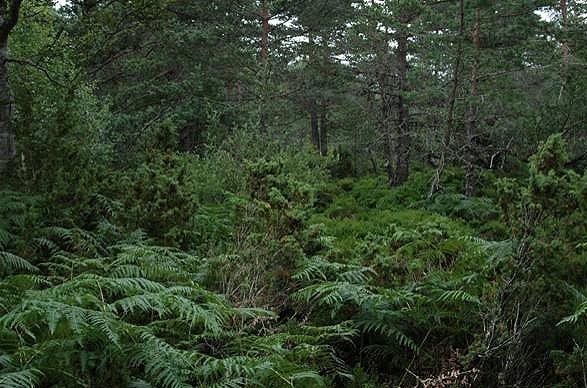Name of the site: Baigura
Protection categories: The environment in which this site lies is included in SCI ES0000129 Sierra de Artxuga, Zarikieta and Montes de Areta, and it is listed as Protected Non-developable Land due to its Environmental Value, Wetlands, in Navarre’s Land Planning Programme 1 “Pyrenees”.
Location: The site is located on the boundary between the municipalities of Abaurrea Baja and Abaurrea Alta.
Region: Navarre
Coordinate reference: XN4449
Surface area of the wetland: 3.44 hectares
Altitude: 1,200 m
This site, which, being practically unaltered, is in an optimum state of conservation, is a very long, acid area without much of a slope. It is at the bottom of a large stream bed beneath a pass and is surrounded by beech trees, peppered with the odd Scots Pine.
This site is a mixed system as far as habitat types are concerned, part of the water coming from underground (minerogenous system), while also having an ombrogenous component (rainwater). The area has a low nutrient content, relatively poor flora and a lot of sphagnum. Its trophic level would seem to indicate conditions of a certain oligotrophic nature.
In the environs, there are more waterlogged nuclei with mats of sphagnum and the development of promontories. The largest waterlogged part, which is the westernmost area, is well developed and of great interest. The plant communities adopt a concentric formation in the more waterlogged areas, with the most hydrophilic species in the centre and beech trees on the boundary of the site, passing through an internal ring of birch trees and an external ring of pine trees and bilberries.
In the drier part, woodland with pine and birch trees, bilberries and heather (Calluna vulgaris) is growing.
On the northernmost edge of the site, there is a stream which collects the water from it.
- MOST IMPORTANT VALUES
Uniqueness
This is one of the only two sites found in Navarre with an ombrogenous component. It borders on the very limit of the definition of peatland, even though its continuous peat deposit does not exceed 45 cm.Biological and ecological values
Almost all the plant communities present at Baigura are rather unique and the presence of Pinus sylvestris var. pyrenaica and Betula pubescens subsp. celtiberica, which draw it close to the status of bog woodland (91D0*), and that of communities of Erica tetralix and Sphagnum magellanicum (Erico tetralicis-Sphagnetum magellanic, 7140) and communities of Narthecium ossifragum and Sphagnum tenellum (Narthecio ossifragi-Sphagnetum tenelli, 7140), the nearest counterparts of which are to be found in Asturias, should all be highlighted.
As far as plant species are concerned, the presence of Salix aurita x atrocinerea, Lastrea limbosperma, Polygonatum verticillatum, Gentiana lutea, Convallaria majalis, Eriophorum angustifolium, Trichophorum caespitosum subsp. germanicum, Nardus stricta and Juncus squarrosus should be stressed. The most noteworthy bryophytes include Calypogeia integristipula, Cephalozia connivens, Cladopodiella fluitans, Kurzia pauciflora, Scapania mucronata, Sphagnum magellanicum, Sphagnum rubellum and Splachnum ampullaceum.Historical and paleoecological values
The site has a poor, non-continuous deposit of peat, but it is believed that peat-forming activity is under way, despite relatively dry summers.Habitats of Community Interest
Hábitat Nombre 4010 Brezales húmedos atlánticos septentrionales de Erica tetralix 6230* Formaciones herbosas con Nardus, con numerosas especies, sobre sustratos silíceos de zonas montañosas (y de zonas submontañosas de la Europa continental) 7140 «Mires» de transición 9120 Hayedos acidófilos atlánticos con sotobosque de Ilex y a veces de Taxus (Quercion robori-petraeae o Ilici-Fagenion) 91D0* Turberas boscosas Flora
66 species of vascular plant and 39 bryophyte species, seven of which are sphagnums, have been recorded.
Of the vascular plants, the most noteworthy presence is that of the hybrid Salix aurita x atrocinerea. The great abundance of Lastrea limbosperma and the presence of Polygonatum verticillatum, Gentiana lutea and Convallaria majalis amongst the birch and beech trees should also be underscored. In the waterlogged areas, the presence of Eriophorum angustifolium and Trichophorum caespitosum subsp. germanicum is notable, as is that of Nardus stricta and Juncus squarrosus in the surrounding grasslands.
As for bryophytes, a few novelties for the catalogue of Navarre are worthy of mention: the hepatics Calypogeia integristipula, Cephalozia connivens, Cladopodiella fluitans, Kurzia pauciflora and Scapania mucronata, and the mosses Sphagnum magellanicum, Sphagnum rubellum and Splachnum ampullaceum, a dung moss. The presence of Sphagnum magellanicum, a particularly peat-forming and ombrophilous sphagnum, is particularly relevant.Fauna
The site is home to the viviparous lizard (Zootoca vivipara), listed as “Near Threatened” by the IUCN and included in Spain’s List of Specially Protected Species.- PHOTOS






